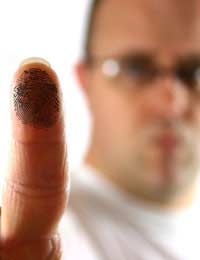Biometric Scanning And Your Privacy

Look at the whorls on your index finger. Every fingerprint is almost entirely unique – that’s why they’ve been dusted for crime detection for more than a century. Technology is moving on. Biometric scanning is the process of checking a fingerprint, iris, or face pattern with a technological device. But what does the mass introduction of Biometrics mean for your privacy?
What is Biometric Scanning?
Biometric scanning is the process of ‘reading’ a physical feature such as fingerprint, iris, face, vein, or voice. When you present your fingerprint or iris, the biometric reader creates a digitised template which will be used to recognise you in the future. The template is stored, either in a central system, or on your card.Where is Biometric Scanning Used?
Biometric scanning is already used in many workplaces, high-tech laptops, and on passports in some European countries. It is also being proposed for the new Identity Cards which could soon be compulsory in the UK.Biometric scanners are currently used to register asylum seekers and monitor travellers passing through major airports. The UK and USA are in discussions about sharing their biometric information in the anti-terror campaign. In Europe, the sharing of information between police and immigration officials is being orchestrated. The Home Secretary recently remarked that the UK could not hope to improve its security systems by remaining inside a “bubble”, insisting that this sharing of personal biometric data is crucial to a safe future.
Is Biometric Scanning Foolproof?
Ever since a secondary school tested out a top-notch Biometrics system for dishing out school dinners, then declared it too slow, and worth another try in 12 months, biometric testing has been something of a laughing matter. Will it really be good enough for our national security?The National Physical Laboratory carried out tests on behalf of the Home Office, which is looking for two methods (a primary and a back-up) to use on the new Identity Cards. The report indicated that minor factors such as a cut finger, poor light, bad positioning, watery eyes or contact lenses influence the success of scanning. 98% of fingerprint scans resulted in the successful acquisition of an image and 100% of facial scans produced a usable image. The report also showed that, once an image was produced, the number of false matches was quite high.
What Are The Risks To Your Privacy From Biometric Scanning?
In terms of privacy, the main concern with biometric scanning is the storage and handling of any data acquired by biometric systems.Storing Your Biometric Data
The UK government does not have a reputation for handling information securely. It’s already tentatively proposed sharing biometric data from the National Identity Register with banks and supermarkets, and is in talks to give out more information to other countries, resulting in a lack of privacy. An ex-MI6 operative said that the National Identity Register is a “present” for terrorists – a fantastic target for misuse or destruction.Using Your Biometric Data
The privacy concerns here are international. Although we’re protected by the European Convention on Human Rights, and by the Data Protection Act, other countries have different laws. Critics are already worried that the new biometric passports will be too easy to read, record, and pass on.- What is RIPA?
- Criminal Records and Privacy
- Credit and Privacy: FAQ
- Myths About Privacy
- Data Protection Act Privacy Notices: What Are They?
- An Example of a Data Protection Act Enquiry
- How to Avoid Stalking
- A New Task Force on Privacy
- Personal Data Blunders in the Uk
- Making a Data Protection Act Enquiry
- The Data Protection Act and How It Works
- How Mobile Phone Tracking Is Used And How It Affects Your Privacy
- Mass Surveillance in the UK- The 'Big Brother' Society
- Financial Security and Privacy
- Personal Privacy Whilst Shopping
- CCTV Cameras And Your Privacy
- Loyalty Cards
- Privacy in Popular Culture
- The Introduction of ID Cards
- Human Rights : Your Rights to Privacy
- Maintaining Personal Privacy
- Keeping Yourself Safe When Using Chip And Pin Cards
- Maintaining Privacy After a Criminal Conviction
- Insuring Your Identity
- Identity Fraud


Re: What Are Your Rights Regarding Email Privacy In The Workplace?
I just got let got notification on my work email that someone gain access and change…
Re: Does Neighbour's Camera Contravene Privacy Rights?
My neighbour opposite has got a camera right across the road into my house I have four other…
Re: Can I Use CCTV to Record Meetings in my Home?
I have been harassed by my neighbour who is constantly makeing fake accusations she has cameras recording my…
Re: Does Neighbour's Camera Contravene Privacy Rights?
My neighbours have installed a motion activated light with a camera that comes on when I walk down my…
Re: Does Neighbour's Camera Contravene Privacy Rights?
I've read about people moaning about theses 360 cameras ,I have one and it's because I have a drug…
Re: Computer Monitoring In The Workplace and Your Privacy
I was dismissed from my post at a gp surgery and had to hand my smart card in to the manager can I…
Re: Do They Have the Right to Use My Photo on Website?
My company hired models to use for their website, catalog and social etc but ended up using some of my…
Re: What Are Your Rights Regarding Email Privacy In The Workplace?
I have a works e mail. and do online training through it at home. We all do. Are all e…
Re: Do They Have the Right to Use My Photo on Website?
I’m proposing to put together a collage of pictures taken over the years of our employees at work, out…
Re: Does Neighbour's Camera Contravene Privacy Rights?
I have been into my garden today and seen my next door neighbour has installed a door bell camera at…